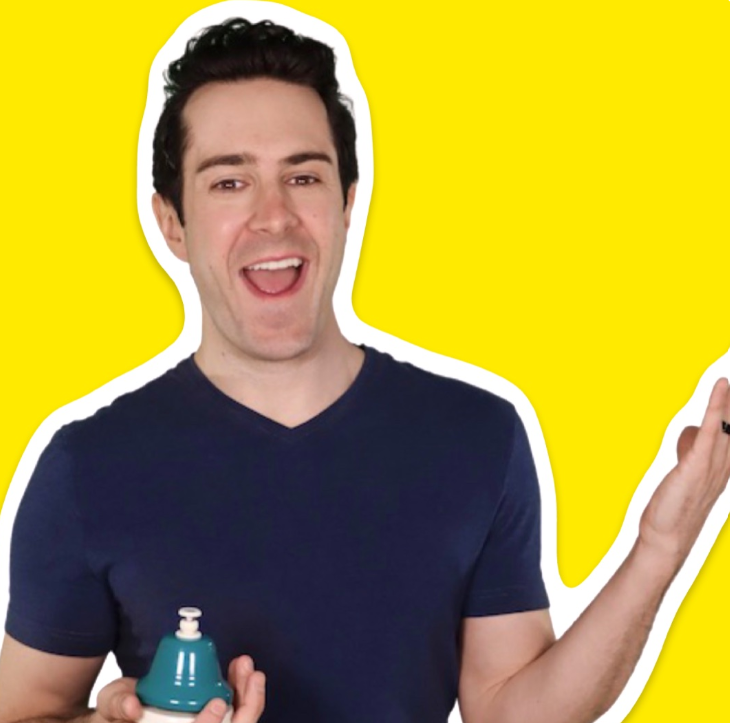There are lots of ways to make money as a creator, but the membership model offers so much more than that. It’s a way to grow a real community, and connect with your members – seeing them learn and grow as they engage with your content over time.
If you’re wondering whether the membership business model is right for you or not, we’re here to help you figure that out. We explain what it is, how it’s different from the subscription model and why it works so well for creators and video membership businesses.
We’ll cover:
- Membership monetization strategies
- How apps are central to membership success
- The key components to a successful membership business
- Is the membership model right for you
- How to start a membership
- Metrics that matter
- Key membership challenges and how to overcome them
What is the membership business model?
The membership business model is similar to a subscription: members pay a regular recurring fee for on-demand access to your membership which includes both content and a community. The key ingredient to the membership model is community.
Members pay to be part of something, where they can connect with others and experience real value from it.
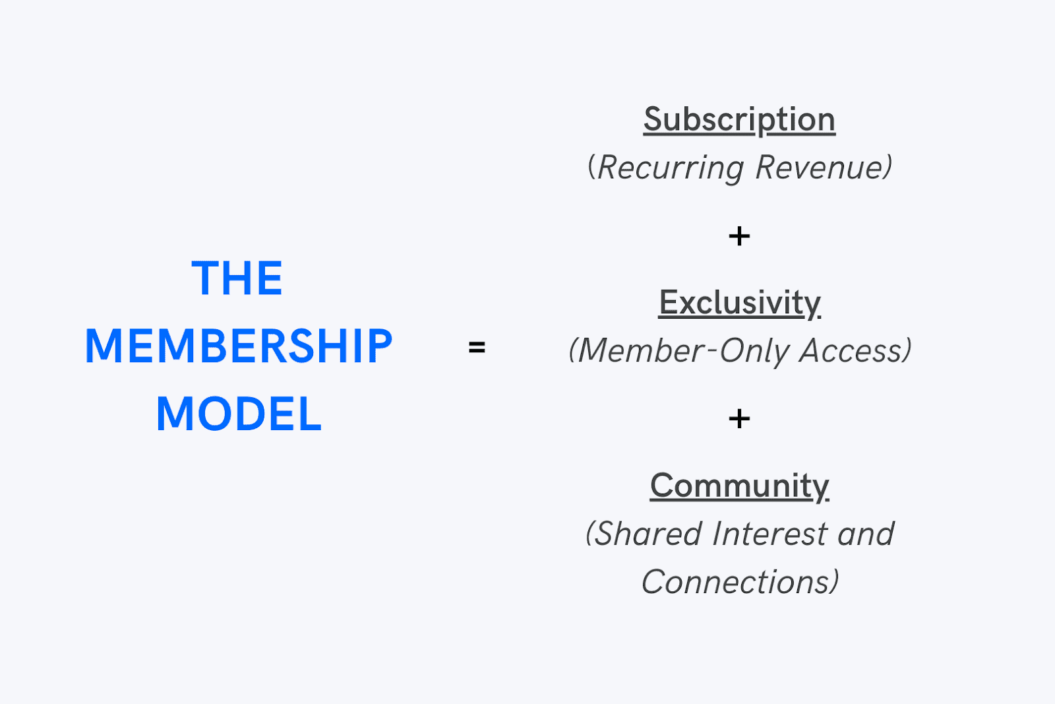
Pilates for Runners is a good example. Members have on-demand access to the workouts and fitness plans, but they also have on-going support from the community to help them stay motivated and get more from it.
Founder Liz patient regularly posts in the community, hosts weekly live sessions and runs monthly challenges. Without this, it would be easy for members to let things slip (and also be more inclined to cancel).

What is the difference between the membership model and the subscription business model?
The subscription business model offers on-demand access to stream video content in exchange for a monthly fee. Popular streaming services like Netflix and Disney Plus are obvious examples of this, but there are plenty of niche, independent streaming subscriptions available, like Means TV for example.
With the subscription model, audiences will expect regular releases of new content and plenty of choice to justify the recurring subscription – because they are just there to enjoy the content. Memberships are a little different, because people join for the experience and you have the space to create a more structured space.
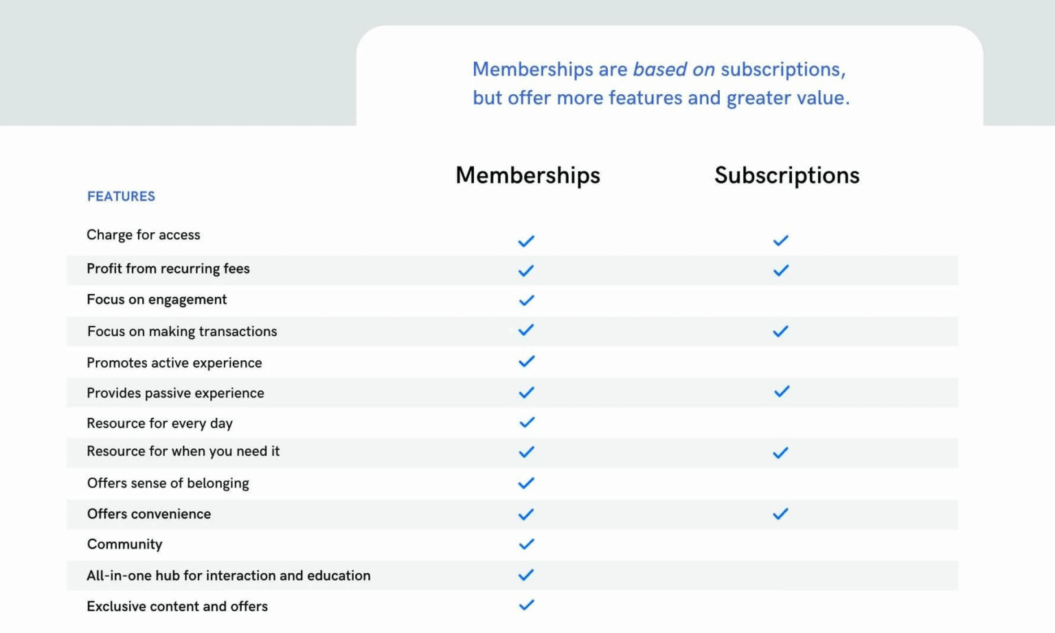
How the subscription business model works
When you hear ‘subscription model’, your mind might go to the subscription box businesses that boomed in the late 2010’s. You might even have paid for some subscription boxes yourself!
But, while almost any product or service can benefit from a subscription business model, let’s bring the subscription model to the world of content with an even better example: Netflix.
Netflix is one of the most popular subscription services today. Let’s take a look at how they use the subscription revenue model…
The streaming service offers 3 subscription tiers: Standard With Adverts, Standard, and Premium.
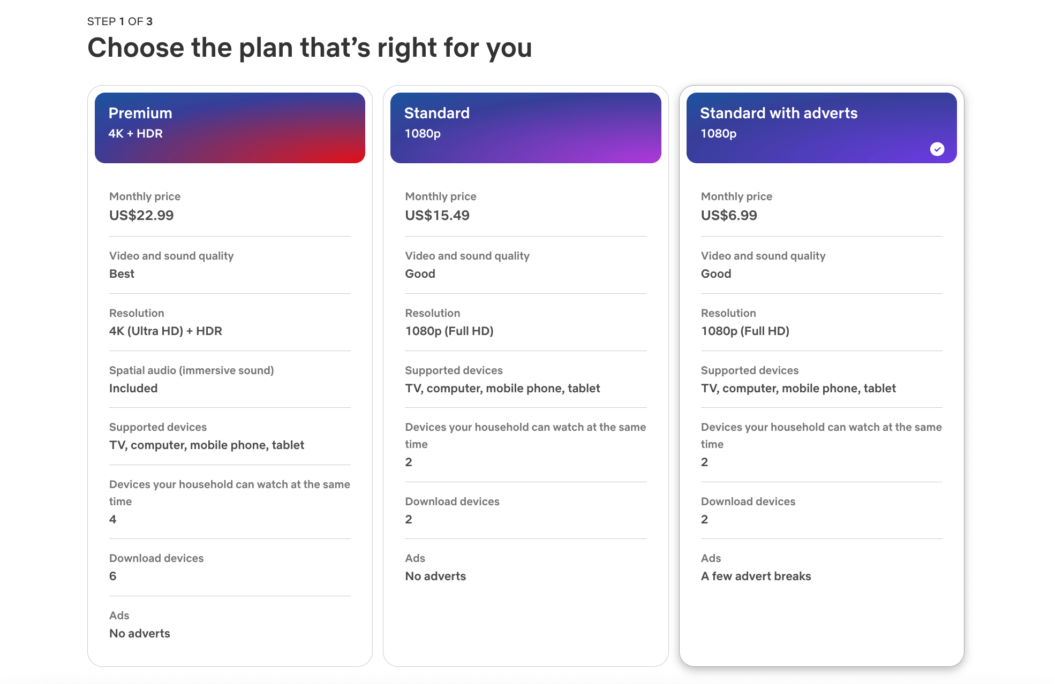
Each tier at various price points provides subscribers different access, features, and benefits.
Users sign up and stick around solely for the volume and quality of content that they receive.
And that’s a double-sided sword. Yes, they generate a huge amount of recurring revenue. But, even Netflix has found it hard to maintain their status as a profitable subscription business.
That’s because with such transactional customer relationships and nothing to keep viewers connected to the service itself, customer loyalty is hard to come by.
After a period of time, some Netflix subscribers might feel that they’re no longer receiving that value, or when they can find better content elsewhere—so they don’t hesitate to click ‘Cancel’. This is called subscriber churn.
The transactional relationship between the creator and subscriber using subscription models can make it seem like it’s a revolving door, where subscribers are leaving as quickly as they’re signing up.
Not to mention that the pressure of having to constantly create new content and get new customer sign-ups often leads to burnout, especially if you’re a small team without a Netflix-sized budget.
Which leads onto our next point, why the membership model could be the solution…
Why the membership business model works so well
Creators and video businesses benefit from the membership model because it’s much more personal than just offering a subscription to your video content. You have recurring revenue coming in, but with a higher level of customer engagement and loyalty, plus the satisfaction of seeing your members enjoy what you’ve built.
Let’s dig into these benefits a bit further.
Stable and predictable revenue stream
It’s possible to make money from the videos you post on social media platforms—provided you have enough subscribers to meet minimum ad share qualifications, and the algorithm doesn’t suppress your content.
But let’s quantify what this actually looks like with an example from TikTok megastar, Hank Green, and his analysis of TikTok’s Creator Fund. In a YouTube video, Green revealed that The Creator Fund paid him a whopping $0.02 to $0.03 for every 1,000 TikTok views.
Let’s compare that with the membership and subscription model. In an influencer Marketing Factory survey, 58% of online content consumers said they’d pay up to $15 monthly to access their favorite creators’ content.
Let’s say you have 500 paying subscribers at $15/per month. That’s $7,500 every month from your video content—without relying on an algorithm.
Big Picture Skiing, a membership site for skiing enthusiasts, surpasses this target. Creator Tom Gellie built the site on the recurring revenue model to monetize his video content with plans available from $349.99 per year.
He now earns over $30K per month with just 300 members.
There’s a clear winner here.
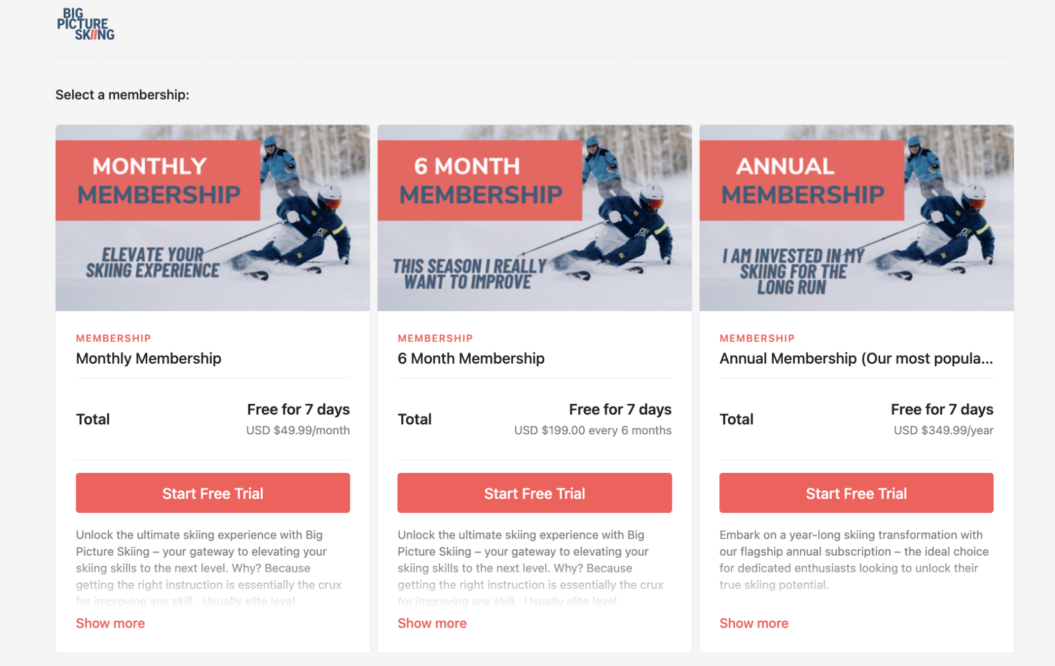
Build community and brand loyalty
If you plan to upsell subscribers to better membership plans, or cross-sell digital products like your online courses, get existing customers to share their candid testimonials and reviews within your membership.
Stats show that 82% of consumers will either research or purchase a product after seeing a member of their community (e.g., friends, family, influencers, etc.) post about it.
Consider the #tiktokmademebuyit fad as anecdotal evidence.
If you look at this hashtag, you’ll notice an interesting trend. People find a new product and make a video about why they love it. Then, other TikTokers see the video, buy the product, and make their own video encouraging others to buy.
The cycle repeats, and soon everyone buys products like Scrub Daddies, The Pink Stuff, and Snow Teeth Whitening.

As mentioned, the subscription business model isn’t only about promoting your video content.
They’re about turning your subscription into a membership and building a community of like-minded individuals who love your content, talk about your videos and products with one another, create hype amongst themselves, and continue to show loyalty.
Audience feedback and insights
Creators who use an all-in-one video platform to run their memberships have exclusive access to feedback and analytics.
In other words: they can interact directly with their community and capture feedback. These member insights help creators refine and improve content based on user needs and preferences.
Not only does capturing feedback and insights benefit you as a creator, but it also helps you build a stronger customer relationship with your members.
Taking in special requests to keep subscribers engaged is a good retention strategy. It gives paying subscribers privileged access to interact with content creators.
Ed Lateef, CEO of Revolution Labs
Personalized member experiences
People favor personalized customer experiences. They’re even willing to pay more for them. Forrester found that 77% of consumers have chosen, recommended, or paid more for personalization.
When your video content lives solely on social media, you can’t deliver personalized experiences to your hungry audience.
You’re at the mercy of the algorithm as to whether or not your content shows up, even when followers are explicitly searching for your videos.
Conversely, when you move to a paid membership model (instead of just using social media subscription services like Facebook Fan Subscriptions), you have complete control over the content and the experience you provide.
Membership business owners who use Uscreen can personalize their member experience by:
- Interacting with members to get real-time feedback on what they want
- Offering tiered memberships to cater to different needs
- Reviewing analytics to see what content resonates with members
- Providing on-demand content across any platform (including desktop, mobile, and smart TVs)
- Setting up search and browsing functionality so members can find whatever content they prefer
The best part: When you provide personalized experiences, members reward you with loyalty.
Membership monetization strategies
The great thing about the membership business model is that you’re in control of how you monetize it. Members are paying you directly, so you can set up your monetization strategy to suit both yours and your members needs.
SVOD vs TVOD & AVOD
That’s a lot of acronyms. Let’s quickly break down what these monetization models are and how you can make use of them.
SVOD (Subscription Video On-Demand): This is the standard subscription model we talked about above. Customers pay a recurring fee for unlimited access to your exclusive content.
Pros:
- Generates recurring revenue
- Plenty of room for growth as you build a loyal customer base
- Ownership over your content and audience
Cons:
- Requires ongoing work to provide value to members
- Member churn means having to keep acquiring new members
- Will require regular creation and release of fresh, new content
TVOD (Transactional Video On-Demand): Better known as pay-per-view, this is where you sell on-off videos or collections which users then keep forever. It’s like buying a film, series or course to watch at your leisure.
Pros:
- Doesn’t require ongoing work to maintain
- You can charge more for high-ticket videos and collections
- You can focus your attention on creating high-quality content
Cons:
- Reliant on one-off sales instead of a recurring subscription fee
- Less opportunity for engagement
- Can’t refresh or update the content
AVOD (Advertising Video On-Demand): This is the freemium model, where your audience can watch your content for free in exchange for being served adverts. You earn through ad revenue here, rather than being paid directly.
Pros:
- Have the potential to reach a higher number of people
- Less commitment required from your audience
- Less to maintain on your side
Cons:
- You need a high number of views to generate decent ad revenue
- Less likely to have predictable income
- You don’t have ownership over your audience
Which monetization model is best for your membership business?
We recommend SVOD for a membership-based business model. This is the best way to get the income you want and build a valuable experience that members want to be part of for the long term. It gives you more control over your membership business including how and what to charge.
You can combine monetization models too, and set yourself up with multiple income streams. Depending on your niche and how you structure your membership, you can easily combine SVOD and TVOD. Let’s look at an example of how Fittest Core does this.
A fitness membership for new and expecting mothers, Fittest Core has a large library of videos to help maintain and regain strength, fitness and wellbeing during pregnancy and after giving birth.
Women can join and pay monthly for full access to everything, or they can purchase a one-off collection to work through at their own pace.
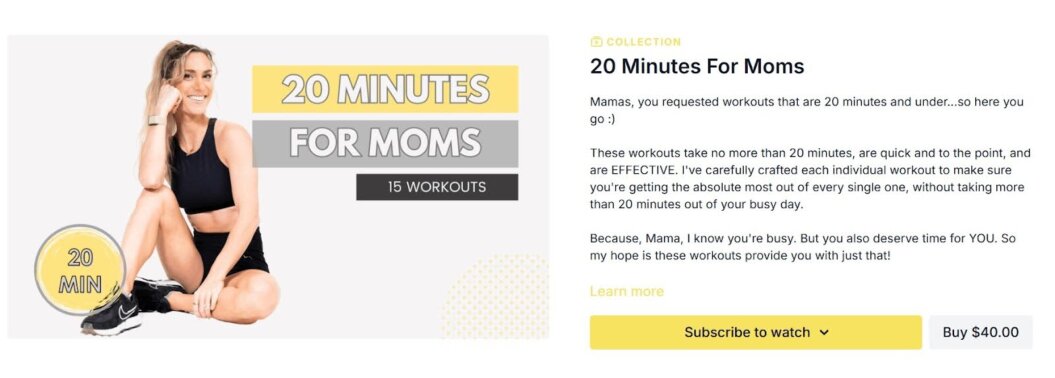
This works well for Fittest Core because it adds flexibility. New mums might feel overwhelmed with the variety available with the paid subscription, and might only want to focus on one fitness program, but others might welcome the support from the wider community to help motivate them on their fitness journey.
Another benefit of the SVOD model means you have room to offer different pricing tiers and payment terms to your target market. For example, you could offer a lower cost version with limited access and then the highest tier has full access to everything plus additional benefits.
The power of upselling
Getting members into an annual plan is a huge benefit to your business strategy. It means you have members paid up for the whole year, rather than risking churn from expected monthly revenue.
Plus annual customers are 16% more likely to renew than monthly ones, increasing the customer lifetime value from your members.
💡Did you know? Uscreen memberships have an upsell feature where you can automatically discount your annual membership and showcase a ‘best value’ banner to attract attention during the sign up process.
It looks like this:
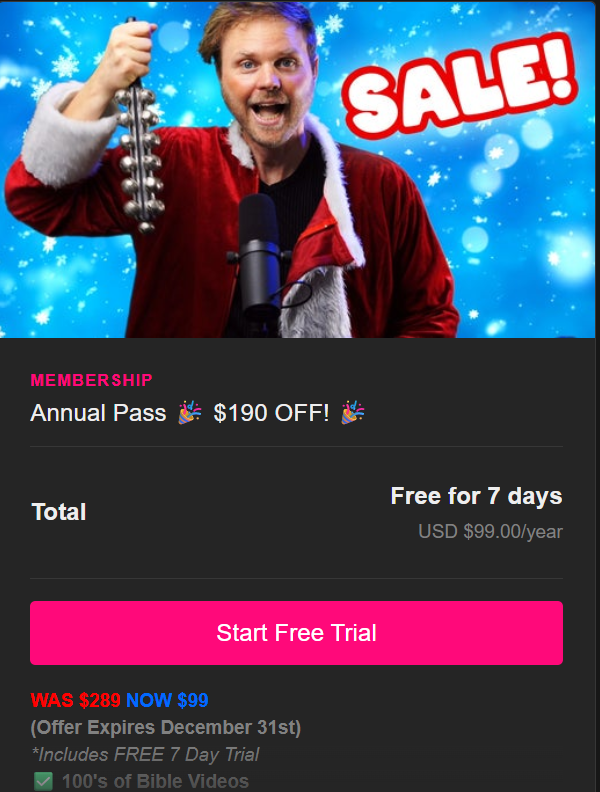
Users see upfront how much money they’d save, and the time limit on the offer gives them the FOMO effect, making them much more likely to choose this option. This leads to more stable and predictable income for you, making it a win on both sides.
Here are the key things you need to know:
- The average length of a monthly user’s membership (aka retention time period) is between 3 and 6 months before they churn.
- Offering a discounted annual membership is actually likely to earn you more money. Members feel like they save money and they’re more motivated to make the most of the membership to get their money’s worth after paying for a year up-front.
Uscreen’s upsell feature was a game-changer! I even reworked my advertising strategy and my landing pages around it. I now funnel everyone into the monthly plan and let the upsell feature do the work. It took our revenue and our subscribers through the roof!
Jason David, MyTRIBE
Nail your membership pricing
Use our pricing tool to find your ideal price point in just 3 quick steps
Use our free tool to pinpoint your ideal membership price in just 3 steps, leveraging a decade of data.
How apps are central to membership success
Apps are an essential part of the membership experience. They’re not just nice to have, they’re central to the way users stream and interact with you and your content.
Uscreen’s new report, ‘The State of Subscription Apps’, analyzed over 3,500 video subscription businesses and their 9 million end-users. From fitness, to faith, to education – here’s what stands out…
Memberships that offer both web and app access:
- See up to a 43% increase in retention
- Experience 220% increase in member engagement
- Sell 121% more annual plans
- Retrain 23% more users after 12 months
- Keep viewers subscribed up to 43% longer
Ownership used to be the final goal in the creator economy. But in 2025, just owning your audience isn’t enough. The creators pulling ahead – the ones scaling revenue, reducing churn, and converting casual fans into lifelong members – are the ones building cross-platform premium services.
I wish I’d done it sooner. Retention improved instantly. It made my content even more accessible—people could just tap the app and go.
Check out a sneak peek of the Pilates for Runners app below:
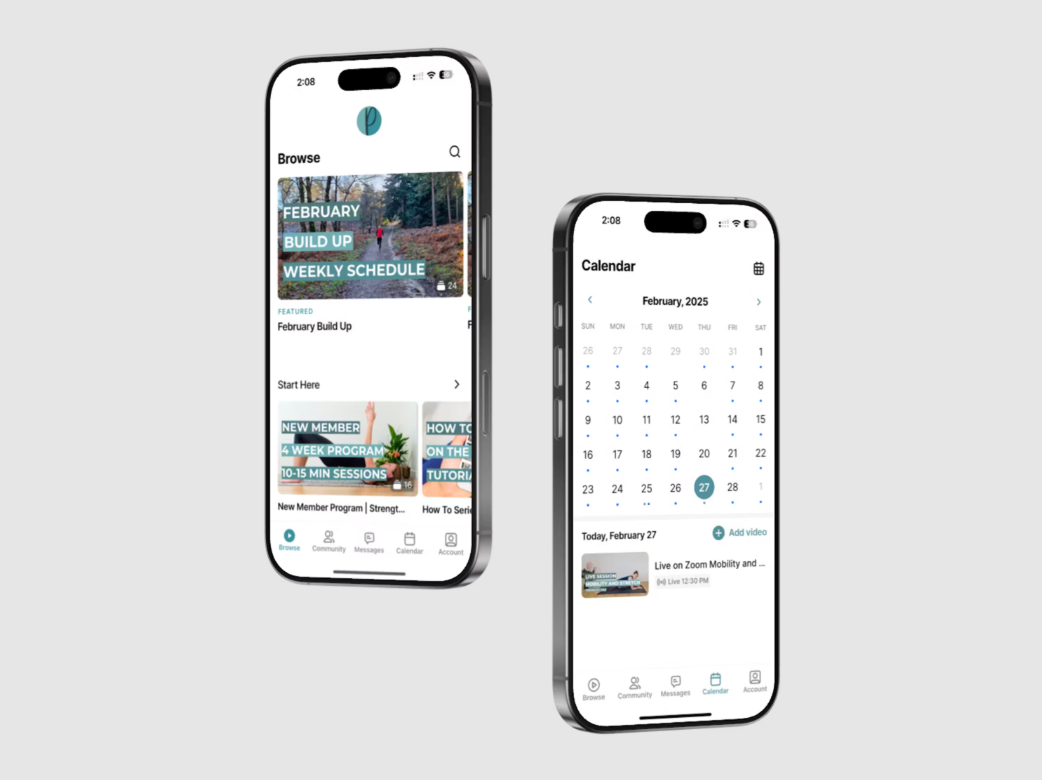
The key components of a successful membership business model
Now that you’re (hopefully) sold on the idea of a membership, let’s talk about what you need to set yourself up for success with a membership business that attracts the right people and fosters customer retention.
Have an existing audience
Before you think about creating a membership, make sure you have an established audience on social media, or your chosen platform. These are your potential paying members; it’s a way of testing out the interest and demand for your content niche and finding out what they want.
Meet the needs of your niche
It’s easy to get carried away with the spark of an idea, but before you do, conduct market research to find out what your audience wants and needs. If there’s a genuine demand for your unique membership, you’ll be able to communicate the value to your target market, building the foundation for success.
Content + community
We always call the community element the ‘secret sauce’ of membership success. This is human connection at its best, something you can’t manufacture.
The sense of belonging, and sharing your interests with like-minded people builds a deeper emotional connection with your membership. It also increases retention by 50% (according to Uscreen customer data).
Top tip: Take the time to interact personally with members in the comments of posts. It makes the community feel more intimate and shows that their contributions are valued.
The right pricing strategy
Successful memberships are those that balance affordability with perceived value, creating a win-win situation for creators and their community. If your membership fee is too high, it can deter potential members. On the other hand, if the pricing is too low, it might not adequately reflect the value of your membership site.
There is no one overall benchmark that anyone should shoot for. What members should shoot for is a size and profitability and sustainability of a business that is kind of right for them.
Regular engagement
This isn’t just about posting new content, but being active in your membership community to create the best possible experience for them. Challenges, live streams, regular check-ins and even just responding to comments and being part of the conversations are all important.
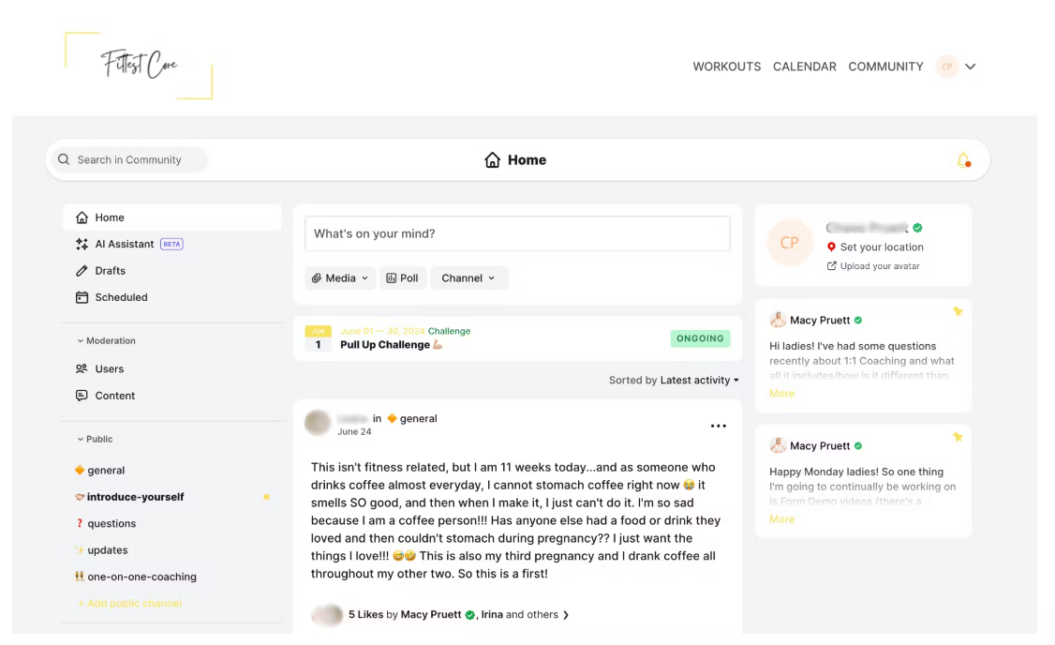
Rob Balasabas, Head of Partnerships & Community here at Uscreen shares how he maintains the value of Uscreen’s Membership Plus for our community:
I ensure that our community has a steady stream of valuable content. This could be exclusive workshops/training, Q&A sessions, or behind-the-scenes insights. For example, we host regular live office hour sessions where members can ask questions directly related to their business/membership challenges.
Marketing funnels
The first hurdle can be getting people into your membership to begin with. Marketing funnels are useful because once you set them up, they keep working away in the background to entice more members to sign up.
The key is setting up the right funnel that will reach the right people, and make it easy for them to sign up.
For example, Rob Young, Founder of Prodigies (online music lessons for kids) successfully uses a free live stream session as a marketing funnel. It works because both kids and parents experience a taster of what’s on offer, and have the chance to connect with the wider community.
The free live streams are like community events – even our paying members show up to say hi. Everyone else who’s considering enrolling gets a feel for the community, and they can see people praising it in real time.
Is the membership model right for you?
If you’re on the fence about whether or not to start a membership, these are the key questions to ask yourself:
- Do you have an existing audience? In our experience, the most successful memberships already have an established following on social media before they launch.
- Can you deliver ongoing value? You’ll need to have the time and resources to keep creating exclusive content and nurturing your community, especially at the start.
- Are you willing to engage regularly? Posting in the community, sending push notifications, hosting live streams and running challenges are all key to maintaining your community.
- Is there a demand for your niche? People need to be willing to pay for your membership to make it viable. Research what competitors are doing, and what your followers are interested in.
- What makes your membership stand out? This forms the basis of your unique selling point (USP). What can you offer that’s different to all the other memberships out there?
Read our dedicated article that takes you through the steps on how to build a video membership business from start to finish, plus access the free template to help shape your business plan.
How To Start A Video Membership Business + Free Template

Membership metrics that matter
Once you launch your membership, it’s time to get stuck into metrics and make data work for your business. The 5 key metrics to focus on are acquisition, revenue, engagement, business health and retention. Sticking to these prevents you from getting overwhelmed with trying to track absolutely everything.
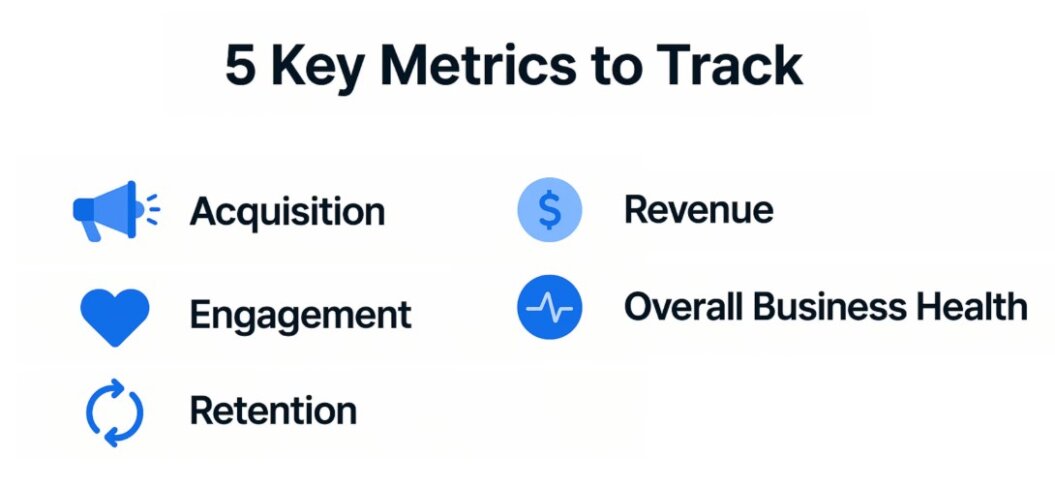
1. Acquisition
In other words, how well are you attracting new members?
- Key metric: Trial conversion rate (the percentage of free trial users who become paying members).
- Why it matters: It tells you how well your free trial works, showing the power of experiencing your membership first hand.
- What it tells you: If your content and onboarding process are strong enough to gain paying members.
How to act on it:
- Improve onboarding – Send welcome emails, set up tutorials and signpost where to start.
- Experiment with the trial length – 7-14 days tends to work well for fitness, while 3 days might work better for education and entertainment.
- Improve incentives to engage regularly – Setting a new member challenge is a great way to get people taking part daily during the free trial.
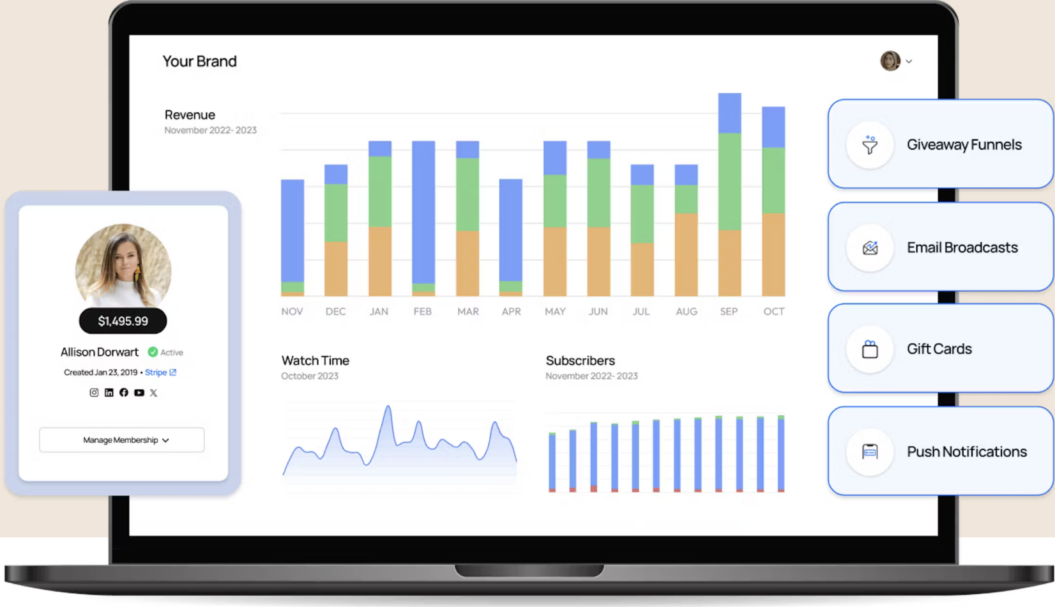
2. Engagement
This tells you if your members are actively using your content.
- Key metric: Viewers (Unique members watching content
- Why it matters: Customer engagement drives retention. If people aren’t watching, they’re more likely to cancel.
- What it tells you: What content is most popular, what isn’t so appealing and how long your members are staying active.
How to act on it:
- Double down on top-performing content: Make more of what your members like.
- Adjust your content calendar or formats: Test out different video lengths, or schedule sessions at varying times.
- Re-engage inactive members: Reach out via email and push notifications with a hook to get them watching something new.
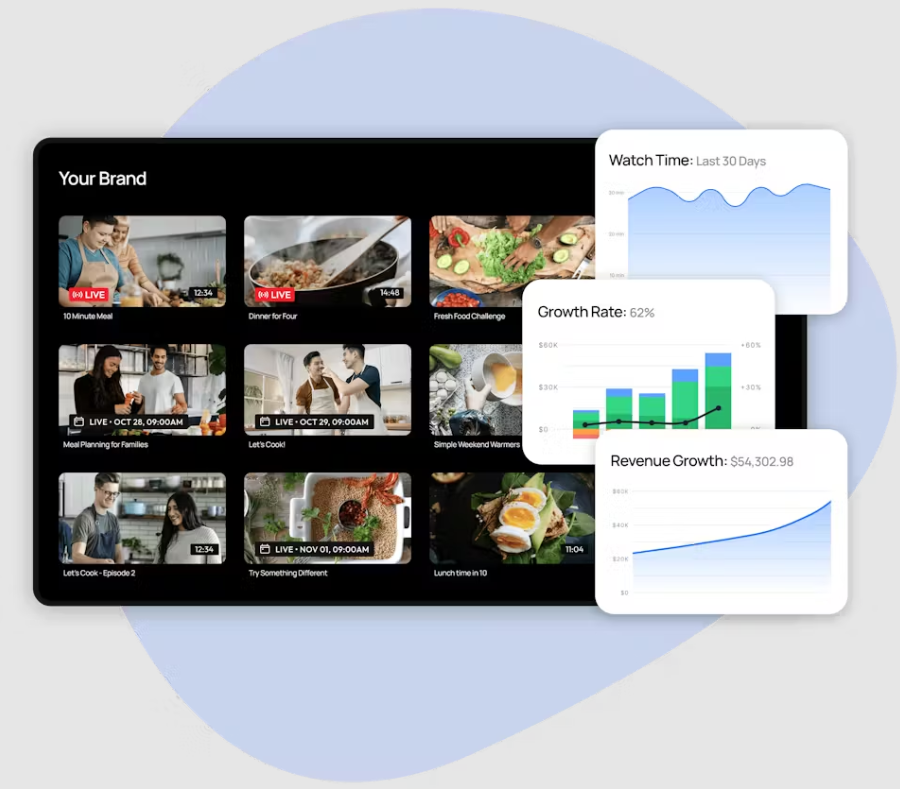
3. Retention
Find out how long your members stick around for.
- Key metric: Churn rate (the percentage of members canceling in a given time frame).
- Why it matters: High churn = growth friction. Low churn = compounding revenue.
- What it tells you: Whether your content, community, and user experience are keeping members engaged.
How to act on it:
- Run cancellation surveys – gather data on why members are cancelling so you can address this.
- Build retention habits early – Start with strong onboarding and post-trial engagement to increase the chances of retention.
- Encourage upgrades –Make longer-term plans more valuable and test retention offers at renewal or cancellation.
- Offer a “pause” option instead of canceling – Catch them before they confirm their cancellation and give them another chance to benefit from the membership at a later date.
4. Revenue
How much are you actually earning?
- Key metric: Net sales (Total revenue before fees)
- Why it matters: Tells you how your business is growing and whether your current strategy is sustainable.
- What it tells you: Whether pricing, sales, and member growth are driving financial progress.
How to act on it:
- Launch promotions or bundles – Make the joining offer as enticing as possible.
- Test new pricing tiers – Find out what works best for your audience
- Explore upsells or exclusive paid content – Add additional options to bring in more revenue
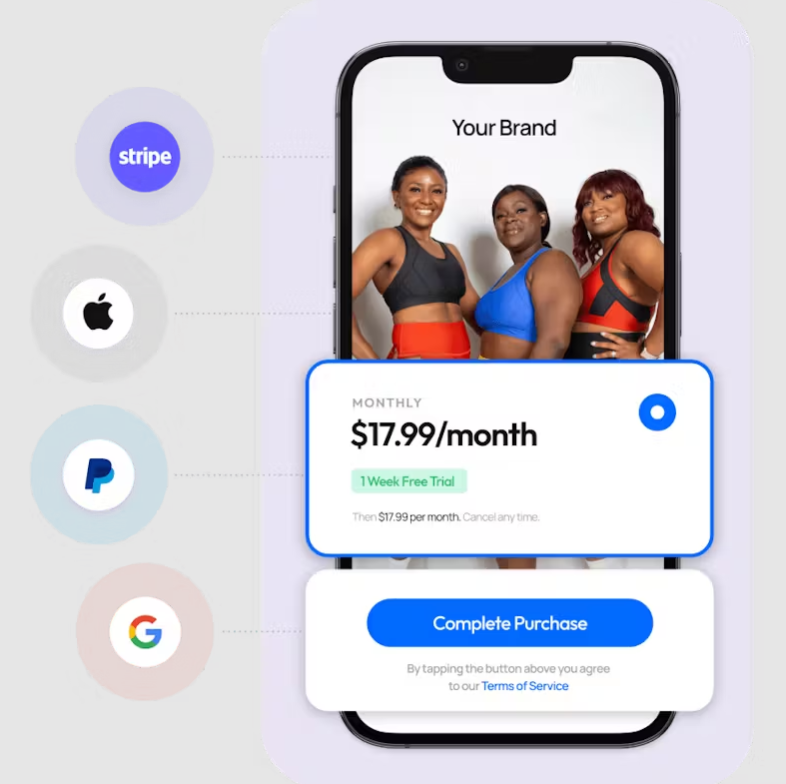
5. Overall business health:
The key question here is: are you growing sustainably?
- Key metric: Monthly recurring revenue (Predictable revenue from subscriptions)
- Why it matters: MRR is your heartbeat. It shows how reliably your business is growing.
- What it tells you: Whether your current growth and retention efforts are building momentum.
How to act on it:
- Set monthly MRR goals and monitor progress – Being able to answer whether or not you’ve achieved your goals gives you solid data to work from.
- Balance efforts between acquisition and retention – Give equal attention to gaining new members and retaining existing ones.
- Use it as your anchor metric to measure strategic changes – For insight into how impactful these changes are.
4 common membership challenges and how to overcome them
Running a membership or subscription business has its challenges, just like any business model. Preparing for these in advance will hopefully reduce some of the anxiety around starting a brand new business by knowing what to expect and how you can tackle these common challenges.
1. Member churn
Retention and preventing churn is one of the biggest challenges that membership businesses face.
Our VP of Growth and Analytics, Joe Horowitz, spends a lot of time thinking about member retention and how it impacts creator businesses.
He breaks retention down into 3 main ‘churn buckets’ that help you to understand when (and why) members leave when they do:
- Activation Churn (First 30 days): This is the most critical period where you can make the biggest impact. Focus on getting new members to engage with your product quickly and see its value.
- Mid-term Churn (The “Fat Middle”): This covers the bulk of the subscription period. It’s the hardest to influence but can be addressed by continually providing value and improving your product.
- End-of-term Churn (Last 30 days): Often related to involuntary churn due to payment issues. While important, this is generally the least controllable aspect of churn.
💡Did you know? It costs 5x more to acquire new customers than it does to keep existing ones. Uscreen’s video membership platform has a reduce churn tool. It’s an automation that kicks in whenever someone tries to cancel, and offers a discount to stay on.
2. Marketing and getting members
Spreading the word about your new membership and getting people in the door is another common challenge. That’s why it’s so important to have a launch strategy. Make a plan and stick to it, and keep posting on social media.
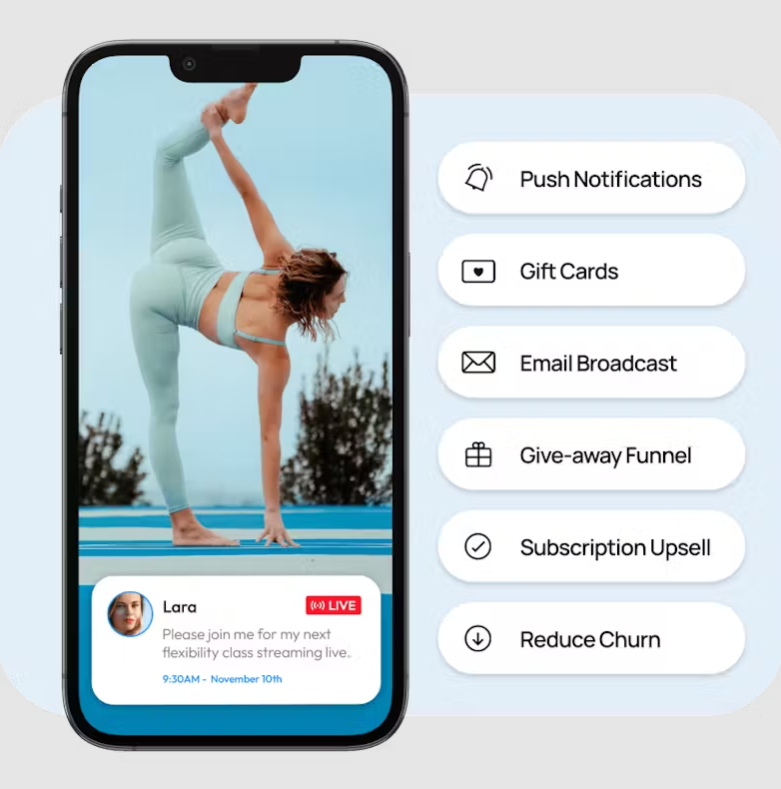
Milou Pietersz shares her tips for making the most of your launch strategy:
- Start promoting your launch 4-6 weeks before you go live
- Share your progress with your followers so they can be part of the journey
- Treat your first launch as a beta launch and refine your membership from there
One mistake that a lot of creators make is not building out a proper launch, but waiting until their membership is live to announce it. Have a plan, be consistent in sticking to it and share your progress so your audience can be part of the journey.
3. Finding the right platform
The right platform to host and run your membership acts like a partnership to help you do your best. It should have all the tools you need to run your membership business, ideally all from one place. The key things to consider include:
- Budget – what price range can you afford?
- Features – what do you need and want to bring your membership to life? What are the must-haves and the nice-to-haves?
- Support – having access to good customer support is essential. Look for platforms that offer onboarding help, in addition to ongoing support.
We’ve rounded up the top 9 membership site platforms to consider in 2025. Check it out!
4. Creator burnout
Burnout is a common problem for creators. In fact, a research report from 2023 uncovered that 79% of content creators have experienced it.
It can be difficult to step off the hamster wheel of constantly creating and publishing content, but the benefit of the membership business model is that you’re in control of how your content reaches your paying audience, not an algorithm.
A membership is more than just content; finding a variety of ways to keep your members engaged (and seeing them thrive) is a great way to maintain a balance.
Here are some strategies you can use to prevent burnout before it creeps in:
- Create content in batches and use this to populate your content calendar for gradual release
- Split up longer videos into shorter ones to help build out your content library
- Set audience expectations so they know how often they can expect new content, or when an exciting new release is coming up
- Host regular live streams for a more intimate, unpolished feel to create a closer connection with your members.
Myths & misconceptions:
“You have to constantly create content.” → You can repurpose, curate, or build community-driven value.
“It’s passive income.” → Recurring, yes. Passive, no.
“Only influencers can do this.” → Audience size helps, but authority and value matters more.
Boost income and retention with an independent membership site
Subscription services and membership businesses have cracked the code to building a predictable revenue stream.
If you’re a video content creator looking to move to a membership or subscription model, there’s good news. You’ve already done the hard work. You’ve fine-tuned your video-making craft and built an audience.
Now, all you need to do is direct that audience to a platform you own, have full control of, and can gain recurring revenue through.
The membership model is profitable, sustainable, and worth the investment for most creators. In other words: it’s the best, most profitable, and most enjoyable way to monetize your video content.
With Uscreen, creators can build a stronger brand, create a more loyal community, and maintain a sustainable business model.
We’ve helped creators earn $150+ million each year, reaching over 9.7 million end-users—and we’re still growing.
Build, launch and manage your membership, all in one place.




